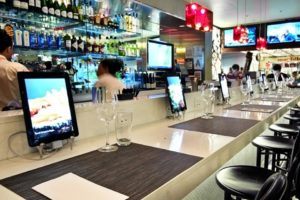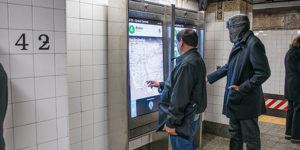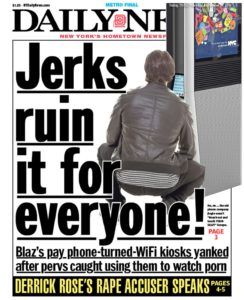Three lessons from building the digital city

Intersection uses tech to transform people’s lives in cities, but the people and the cities present design challenges
Intersection, backed by the Alphabet company Sidewalk Labs, is a technology company that redefines the urban experience. The company’s most high-profile project has been LinkNYC, free gigabit speed WiFi kiosks that it has begun installing throughout New York City and just announced would be expanding to London and other cities soon.[1]
Deploying complex technology in public spaces can be challenging, though. As it develops and tests new products, Intersection is demonstrating some core lessons about the digital transformation of cities.
1. Human interactions matter
Technology in urban spaces can change how we interact. In creating an immersive experience for the new Edward M. Kennedy Institute for the Senate, Scott Anderson of Intersection wrote that “Despite more than 50 custom applications developed for the experience, we wanted the technology to facilitate inter-personal conversation and collaboration. The main attraction is the people, not the technology.”[2]
 Similarly, interaction was a key concern when OTG Management hired Intersection to change the customer experience in airports such as Delta’s terminal in La Guardia. The iPad app Intersection developed to automate the restaurant ordering process increased sales by 15-20% per customer while also speeding up service and turning tables faster. Apparently, not having to flag down a waiter is a very profitable operating change. But other interactions are important to the vibe of a restaurant space. OTG Management CEO Rick Blatstein was pleased to find that rather than isolating customers, iPads “add electricity to a room. What you see are a lot of people talking to each other. They do ‘the lean’ over to another customer to talk about something they read on an iPad, and that causes more social interaction than we had before.”[3]
Similarly, interaction was a key concern when OTG Management hired Intersection to change the customer experience in airports such as Delta’s terminal in La Guardia. The iPad app Intersection developed to automate the restaurant ordering process increased sales by 15-20% per customer while also speeding up service and turning tables faster. Apparently, not having to flag down a waiter is a very profitable operating change. But other interactions are important to the vibe of a restaurant space. OTG Management CEO Rick Blatstein was pleased to find that rather than isolating customers, iPads “add electricity to a room. What you see are a lot of people talking to each other. They do ‘the lean’ over to another customer to talk about something they read on an iPad, and that causes more social interaction than we had before.”[3]
2. Different conditions require different designs
 Getting around the NYC subway system is notoriously difficult, and in 2013 the system was long overdue for a digital navigation system. Setting up a public system, though, is not as easy as putting an iPad on a wall. Working with the MTA, Intersection developed a concept for a touchscreen navigation system to be mounted in some of the city’s busiest stations, but the initial rollout was far from easy. When Intersection installed a test kiosk, they found that the touch sensor technology on the large screen, which relied on microphones, did not perform as well in the loud and rumbling subway station as it had in a glass-enclosed Manhattan office building. After six months of redesigns and bureaucratic wrangling with the MTA, Intersection launched a more durable version with new touch sensor technology and an improved interface.[4]
Getting around the NYC subway system is notoriously difficult, and in 2013 the system was long overdue for a digital navigation system. Setting up a public system, though, is not as easy as putting an iPad on a wall. Working with the MTA, Intersection developed a concept for a touchscreen navigation system to be mounted in some of the city’s busiest stations, but the initial rollout was far from easy. When Intersection installed a test kiosk, they found that the touch sensor technology on the large screen, which relied on microphones, did not perform as well in the loud and rumbling subway station as it had in a glass-enclosed Manhattan office building. After six months of redesigns and bureaucratic wrangling with the MTA, Intersection launched a more durable version with new touch sensor technology and an improved interface.[4]
 3. New technology can have unexpected use cases
3. New technology can have unexpected use cases
The LinkNYC launch was perhaps the biggest challenge for Intersection. While the kiosks provided excellent service and got a positive reception from users, complaints from business owners near the kiosks started coming quickly after launch. In midtown, homeless people were setting up their camps around the kiosks to monopolize the free browsers, and in some cases were using those public screens to watch porn. In response, Intersection switched off the browser screens as they worked with the city for a long-term solution.[5]
In addition to the design and human interface challenges on the operational side that Intersection faces, it also faces business model challenges. With city budgets often tight and governments unwilling to make risky bets on new technology, Intersection must in many cases self-fund its projects with ad revenue. In a place like the streets and subways of New York City where density and ad rates are high, that is possible. As the company seek to work in other regions, however, they will need to find different models, from data capturing and analysis to subscriptions to government subsidy.
[610 words]
Sources
[1] Ingrid Lunden, “LinkNYC’s free WiFi and phone kiosks hit London as LinkUK, in partnership with BT,“ Tech Crunch, October 25, 2016, [https://techcrunch.com/2016/10/25/linknycs-free-wifi-and-phone-kiosks-hit-london-as-linkuk-in-partnership-with-bt/] accessed November 2016.
[2] Kristin Hohenadel, “The Ted Kennedy Institute Combines Cutting-Edge Tech With a Full-Scale Senate Chamber Replica,” Slate, March 31, 2015, [http://www.slate.com/blogs/the_eye/2015/03/31/edward_m_kennedy_institute_for_the_u_s_senate_a_high_tech_digital_museum.html] accessed November 2016.
[3] Eric Lai, “Restaurateur Bringing 7,000 iPads to Airports: We’re Seeing 15-20% Revenue Boost,” Forbes BrandVoice, July 11, 2012, [http://www.forbes.com/sites/sap/2012/07/11/restaurateur-bringing-7000-ipads-to-airports-were-seeing-15-20-revenue-boost/#13d42ba9270b] accessed November 2016.
[4] Mario Aguilar, “NYC’s Touchscreen Subway Maps Are Finally Here, and They’re Amazing,” Gizmodo, February 12, 2014, [http://gizmodo.com/nycs-touchscreen-subway-maps-are-finally-here-and-the-1520953121] accessed November 2016.
[5] Patrick McGeehan, “Free Wi-Fi Kiosks Were to Aid New Yorkers. An Unsavory Side Has Spurred a Retreat.” New York Times, September 14, 2016, [http://www.nytimes.com/2016/09/15/nyregion/internet-browsers-to-be-disabled-on-new-yorks-free-wi-fi-kiosks.html] accessed November 2016.
Images
LinkNYC [https://link.nyc/] accessed November 2016.
iPad Ordering at LaGuardia, Forbes BrandVoice, July 11, 2012 [http://www.forbes.com/sites/sap/2012/07/11/restaurateur-bringing-7000-ipads-to-airports-were-seeing-15-20-revenue-boost/#782e022a270b] accessed November 2016.
MTA On the Go kiosk, Intersection [http://dcjesirewyqdw.cloudfront.net/mta.html] accessed November 2016.
Cover, New York Daily News, September 14, 2016 [http://www.nydailynews.com/new-york/porn-complaints-prompt-city-web-browsing-free-kiosks-article-1.2792500] accessed November 2016.



Great post, Peter! Sidewalk Labs is a fascinating company and Intersection has certainly received a lot of press lately. You raise an interesting point about the iterative nature of implementing digital products in the public sphere – since the public generally expects a public roll-out of a service to be in its final form, this poses problems for beta testing, iteration and adaptation, all necessary for fully functional digital products. In addition, I’m intrigued by the idea of implementation in different regions. Perhaps a product like LinkNYC would be significantly more impactful in a region where smartphones and tablets are less prevalent, though funding will certainly be more difficult, as you point out.
Nice post Peter! Clearly NYC is pushing the boundaries on how tech is used in an urban environment. I wonder if the digital signage is the best use of tax dollars – wouldn’t it be more effective to make WiFi more accessible, so people could access the Subway information on their phones? That way they can read their directions on the go AND you eliminate the complexity of the interactive signs. Just a thought.
Great question, MrNMS! I agree that wifi (and better cell service!) is a huge priority for subways. Transit Wireless has been working with New York City to improve wifi and cell service in the subways, but it’s a slow process. I remember the frustration on my commute of only having a few stations on the route have cell service, so I always knew the exact moment to pull my phone out to check email on the ride—not exactly what should be happening in a 21st century city.
It’s important to understand, though, that most of these interventions are not using taxpayer dollars. The MTA On the Go program is entirely funded through ad revenue, so Intersection takes all the risk. In the case of the LinkNYC wifi kiosks, there is also revenue sharing with the city—over twelve years, LinkNYC is expected to provide about $500 million back to the city.[1] This is a great way to allow for innovation while protecting taxpayer funds. Unfortunately, it’s a harder model to make work in less dense areas where ads are seen by fewer people and therefore command lower rates.
[1] NYC Dept. of Information Technology and Telecommunication, LinkNYC, [https://www1.nyc.gov/site/doitt/initiatives/linknyc.page] accessed November 2016.
Hey Peter,
Very cool post! I was especially interested to read about the unique and unanticipated challenges that Intersection has faced in implementation.
Would be useful to know a little bit more about Intersection’s revenue model — does the city contract these services out? Is it a one-time fee or subscription basis? What do their margins look like?
I would also love to hear from your perspective how the city thinks about the cost-benefit analysis for these kinds of investments. As you mentioned, we live in a world with finite public resources, so it seems to me like a tough decision to know when to spend on these kinds of technological advances in a context when budgets for basic service provision around the world are often getting hit. Can Intersection directly attribute cost savings in other government spending categories linked to its services?